Comprehensive Analysis of Logistics and Supply Chain Management Report
VerifiedAdded on 2020/05/08
|18
|4464
|238
Report
AI Summary
This report provides a comprehensive overview of logistics and supply chain management, beginning with an executive summary that defines logistics and its importance. It then delves into the significance of logistics in a global environment, highlighting its role in customer loyalty and competitive advantage. The analysis section examines transportation management, warehousing, supply chain dynamics, and inventory management. The report further explores the application of logistics theories in various fields, including military, business, and production, detailing how these theories address strategic, tactical, and operational functions. It also mentions the use of regression models in logistics. The report concludes by addressing the challenges inherent in logistics management.
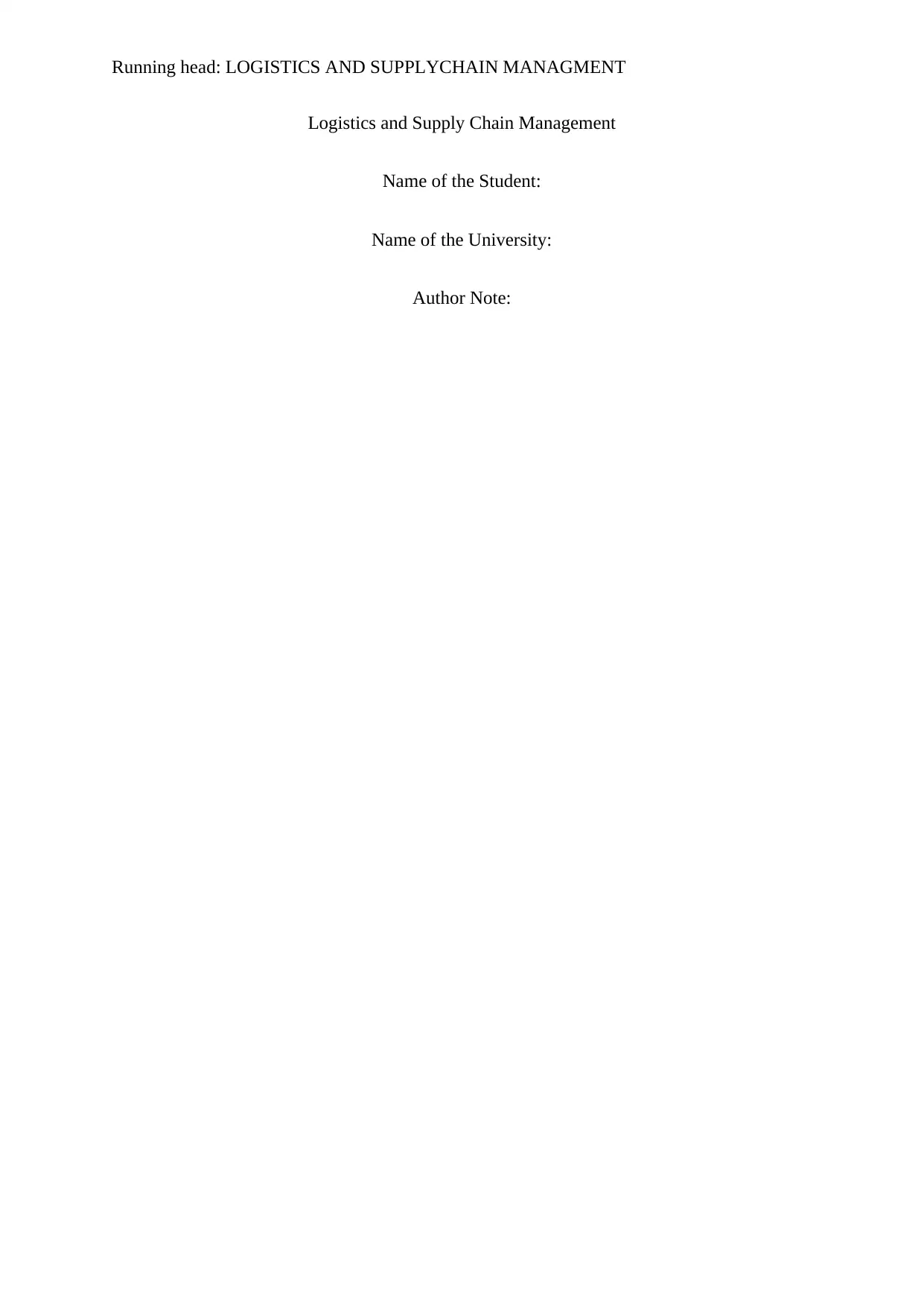
Running head: LOGISTICS AND SUPPLYCHAIN MANAGMENT
Logistics and Supply Chain Management
Name of the Student:
Name of the University:
Author Note:
Logistics and Supply Chain Management
Name of the Student:
Name of the University:
Author Note:
Paraphrase This Document
Need a fresh take? Get an instant paraphrase of this document with our AI Paraphraser
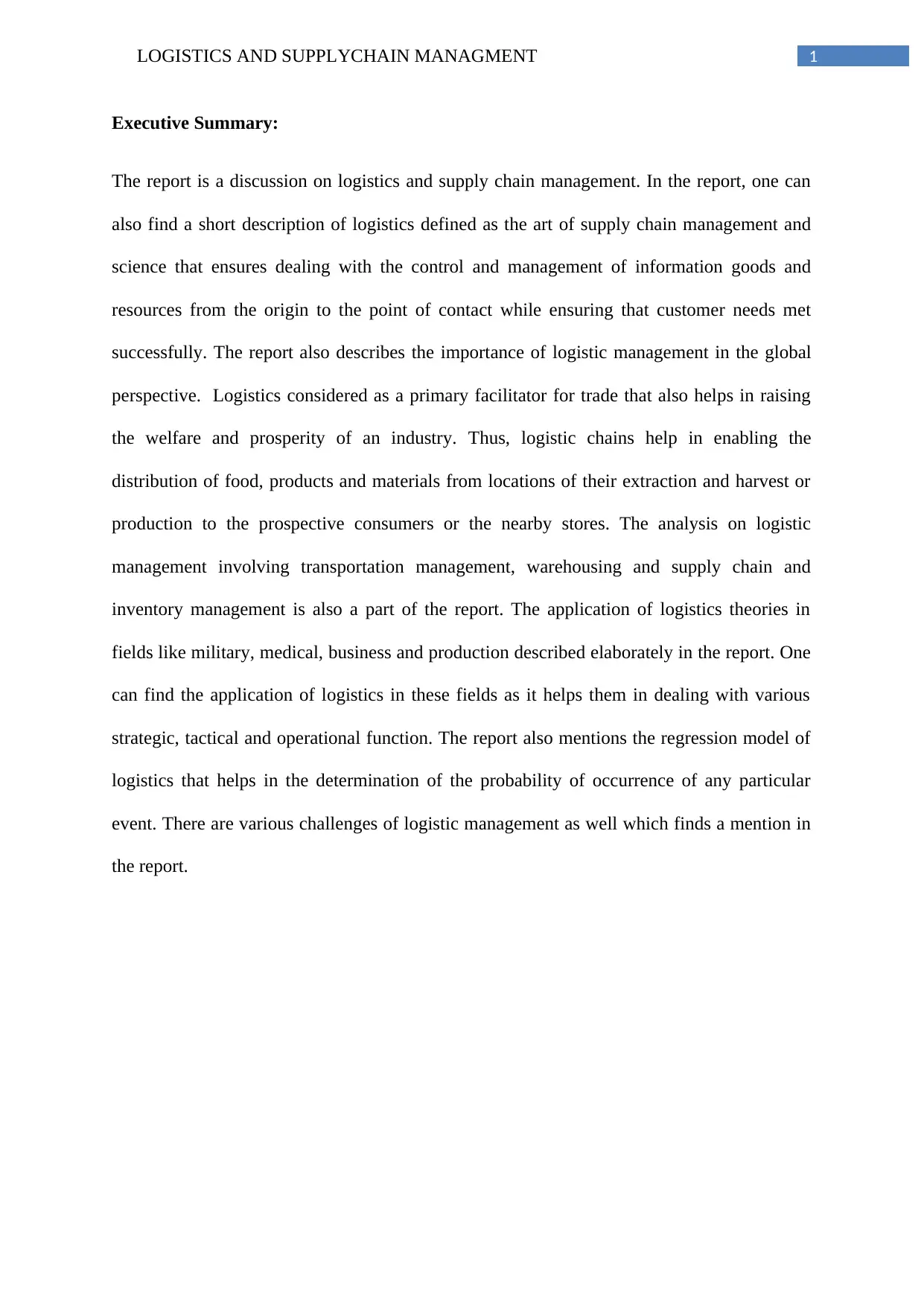
1LOGISTICS AND SUPPLYCHAIN MANAGMENT
Executive Summary:
The report is a discussion on logistics and supply chain management. In the report, one can
also find a short description of logistics defined as the art of supply chain management and
science that ensures dealing with the control and management of information goods and
resources from the origin to the point of contact while ensuring that customer needs met
successfully. The report also describes the importance of logistic management in the global
perspective. Logistics considered as a primary facilitator for trade that also helps in raising
the welfare and prosperity of an industry. Thus, logistic chains help in enabling the
distribution of food, products and materials from locations of their extraction and harvest or
production to the prospective consumers or the nearby stores. The analysis on logistic
management involving transportation management, warehousing and supply chain and
inventory management is also a part of the report. The application of logistics theories in
fields like military, medical, business and production described elaborately in the report. One
can find the application of logistics in these fields as it helps them in dealing with various
strategic, tactical and operational function. The report also mentions the regression model of
logistics that helps in the determination of the probability of occurrence of any particular
event. There are various challenges of logistic management as well which finds a mention in
the report.
Executive Summary:
The report is a discussion on logistics and supply chain management. In the report, one can
also find a short description of logistics defined as the art of supply chain management and
science that ensures dealing with the control and management of information goods and
resources from the origin to the point of contact while ensuring that customer needs met
successfully. The report also describes the importance of logistic management in the global
perspective. Logistics considered as a primary facilitator for trade that also helps in raising
the welfare and prosperity of an industry. Thus, logistic chains help in enabling the
distribution of food, products and materials from locations of their extraction and harvest or
production to the prospective consumers or the nearby stores. The analysis on logistic
management involving transportation management, warehousing and supply chain and
inventory management is also a part of the report. The application of logistics theories in
fields like military, medical, business and production described elaborately in the report. One
can find the application of logistics in these fields as it helps them in dealing with various
strategic, tactical and operational function. The report also mentions the regression model of
logistics that helps in the determination of the probability of occurrence of any particular
event. There are various challenges of logistic management as well which finds a mention in
the report.
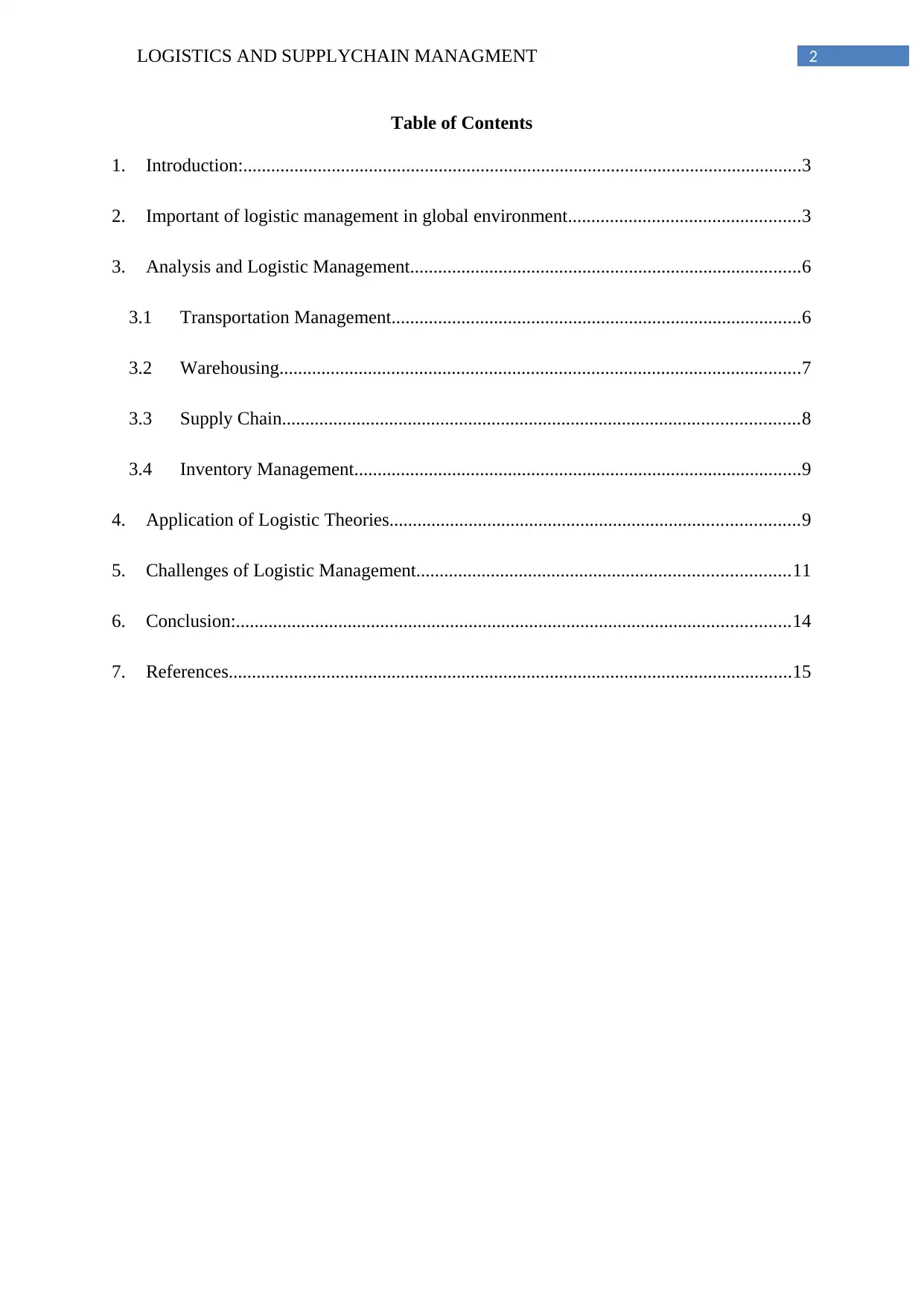
2LOGISTICS AND SUPPLYCHAIN MANAGMENT
Table of Contents
1. Introduction:........................................................................................................................3
2. Important of logistic management in global environment..................................................3
3. Analysis and Logistic Management....................................................................................6
3.1 Transportation Management........................................................................................6
3.2 Warehousing................................................................................................................7
3.3 Supply Chain...............................................................................................................8
3.4 Inventory Management................................................................................................9
4. Application of Logistic Theories........................................................................................9
5. Challenges of Logistic Management................................................................................11
6. Conclusion:.......................................................................................................................14
7. References.........................................................................................................................15
Table of Contents
1. Introduction:........................................................................................................................3
2. Important of logistic management in global environment..................................................3
3. Analysis and Logistic Management....................................................................................6
3.1 Transportation Management........................................................................................6
3.2 Warehousing................................................................................................................7
3.3 Supply Chain...............................................................................................................8
3.4 Inventory Management................................................................................................9
4. Application of Logistic Theories........................................................................................9
5. Challenges of Logistic Management................................................................................11
6. Conclusion:.......................................................................................................................14
7. References.........................................................................................................................15
⊘ This is a preview!⊘
Do you want full access?
Subscribe today to unlock all pages.

Trusted by 1+ million students worldwide
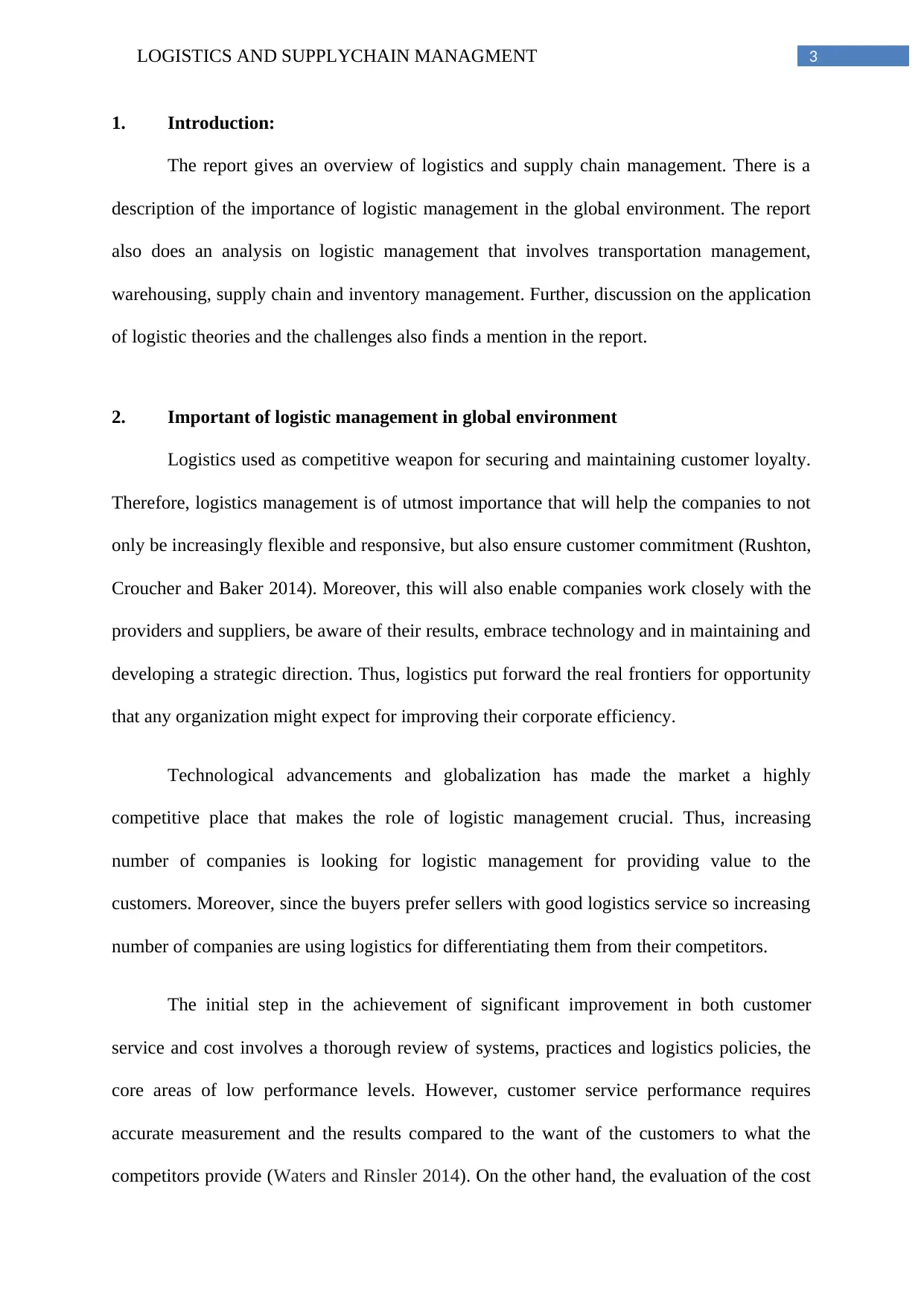
3LOGISTICS AND SUPPLYCHAIN MANAGMENT
1. Introduction:
The report gives an overview of logistics and supply chain management. There is a
description of the importance of logistic management in the global environment. The report
also does an analysis on logistic management that involves transportation management,
warehousing, supply chain and inventory management. Further, discussion on the application
of logistic theories and the challenges also finds a mention in the report.
2. Important of logistic management in global environment
Logistics used as competitive weapon for securing and maintaining customer loyalty.
Therefore, logistics management is of utmost importance that will help the companies to not
only be increasingly flexible and responsive, but also ensure customer commitment (Rushton,
Croucher and Baker 2014). Moreover, this will also enable companies work closely with the
providers and suppliers, be aware of their results, embrace technology and in maintaining and
developing a strategic direction. Thus, logistics put forward the real frontiers for opportunity
that any organization might expect for improving their corporate efficiency.
Technological advancements and globalization has made the market a highly
competitive place that makes the role of logistic management crucial. Thus, increasing
number of companies is looking for logistic management for providing value to the
customers. Moreover, since the buyers prefer sellers with good logistics service so increasing
number of companies are using logistics for differentiating them from their competitors.
The initial step in the achievement of significant improvement in both customer
service and cost involves a thorough review of systems, practices and logistics policies, the
core areas of low performance levels. However, customer service performance requires
accurate measurement and the results compared to the want of the customers to what the
competitors provide (Waters and Rinsler 2014). On the other hand, the evaluation of the cost
1. Introduction:
The report gives an overview of logistics and supply chain management. There is a
description of the importance of logistic management in the global environment. The report
also does an analysis on logistic management that involves transportation management,
warehousing, supply chain and inventory management. Further, discussion on the application
of logistic theories and the challenges also finds a mention in the report.
2. Important of logistic management in global environment
Logistics used as competitive weapon for securing and maintaining customer loyalty.
Therefore, logistics management is of utmost importance that will help the companies to not
only be increasingly flexible and responsive, but also ensure customer commitment (Rushton,
Croucher and Baker 2014). Moreover, this will also enable companies work closely with the
providers and suppliers, be aware of their results, embrace technology and in maintaining and
developing a strategic direction. Thus, logistics put forward the real frontiers for opportunity
that any organization might expect for improving their corporate efficiency.
Technological advancements and globalization has made the market a highly
competitive place that makes the role of logistic management crucial. Thus, increasing
number of companies is looking for logistic management for providing value to the
customers. Moreover, since the buyers prefer sellers with good logistics service so increasing
number of companies are using logistics for differentiating them from their competitors.
The initial step in the achievement of significant improvement in both customer
service and cost involves a thorough review of systems, practices and logistics policies, the
core areas of low performance levels. However, customer service performance requires
accurate measurement and the results compared to the want of the customers to what the
competitors provide (Waters and Rinsler 2014). On the other hand, the evaluation of the cost
Paraphrase This Document
Need a fresh take? Get an instant paraphrase of this document with our AI Paraphraser
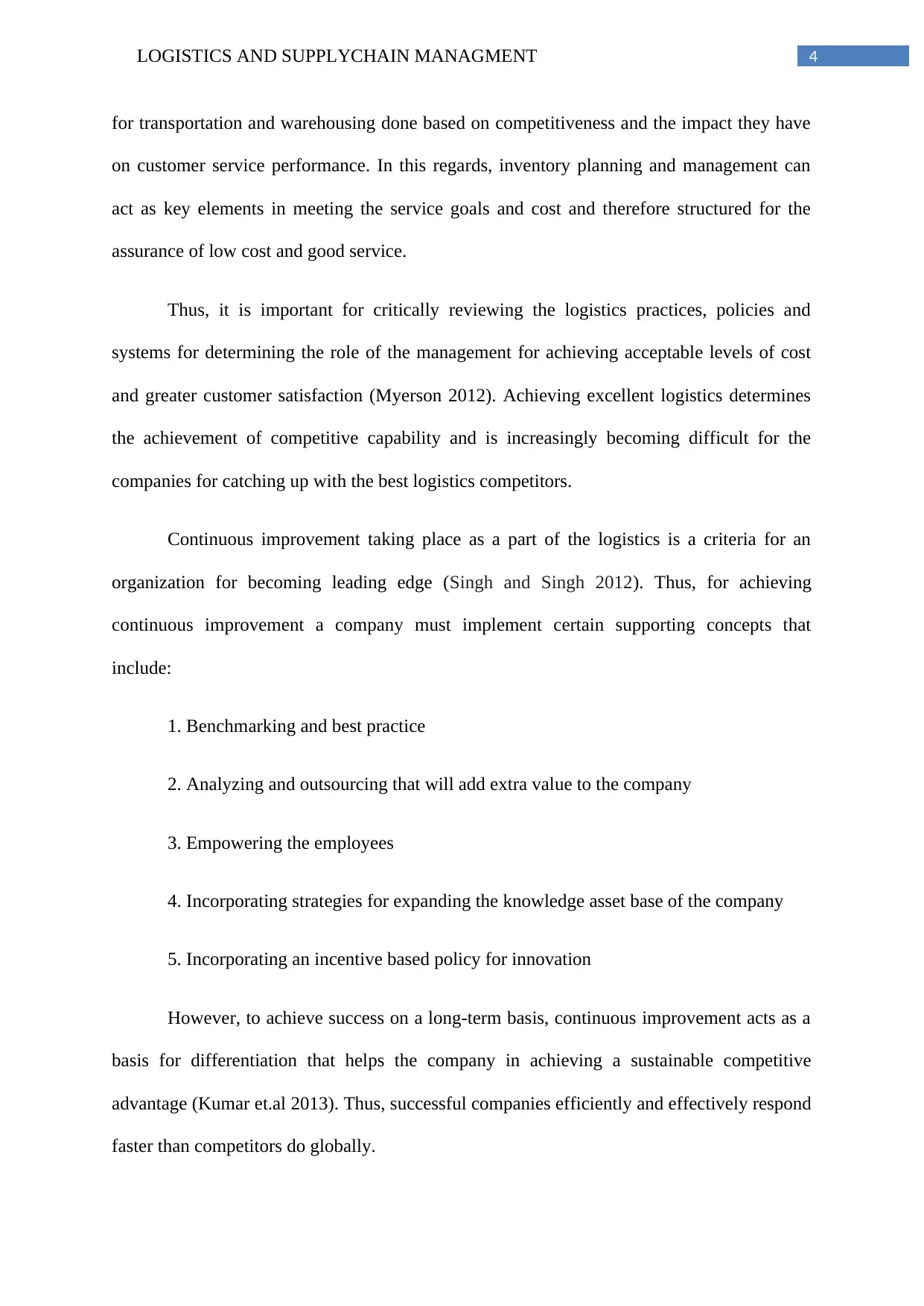
4LOGISTICS AND SUPPLYCHAIN MANAGMENT
for transportation and warehousing done based on competitiveness and the impact they have
on customer service performance. In this regards, inventory planning and management can
act as key elements in meeting the service goals and cost and therefore structured for the
assurance of low cost and good service.
Thus, it is important for critically reviewing the logistics practices, policies and
systems for determining the role of the management for achieving acceptable levels of cost
and greater customer satisfaction (Myerson 2012). Achieving excellent logistics determines
the achievement of competitive capability and is increasingly becoming difficult for the
companies for catching up with the best logistics competitors.
Continuous improvement taking place as a part of the logistics is a criteria for an
organization for becoming leading edge (Singh and Singh 2012). Thus, for achieving
continuous improvement a company must implement certain supporting concepts that
include:
1. Benchmarking and best practice
2. Analyzing and outsourcing that will add extra value to the company
3. Empowering the employees
4. Incorporating strategies for expanding the knowledge asset base of the company
5. Incorporating an incentive based policy for innovation
However, to achieve success on a long-term basis, continuous improvement acts as a
basis for differentiation that helps the company in achieving a sustainable competitive
advantage (Kumar et.al 2013). Thus, successful companies efficiently and effectively respond
faster than competitors do globally.
for transportation and warehousing done based on competitiveness and the impact they have
on customer service performance. In this regards, inventory planning and management can
act as key elements in meeting the service goals and cost and therefore structured for the
assurance of low cost and good service.
Thus, it is important for critically reviewing the logistics practices, policies and
systems for determining the role of the management for achieving acceptable levels of cost
and greater customer satisfaction (Myerson 2012). Achieving excellent logistics determines
the achievement of competitive capability and is increasingly becoming difficult for the
companies for catching up with the best logistics competitors.
Continuous improvement taking place as a part of the logistics is a criteria for an
organization for becoming leading edge (Singh and Singh 2012). Thus, for achieving
continuous improvement a company must implement certain supporting concepts that
include:
1. Benchmarking and best practice
2. Analyzing and outsourcing that will add extra value to the company
3. Empowering the employees
4. Incorporating strategies for expanding the knowledge asset base of the company
5. Incorporating an incentive based policy for innovation
However, to achieve success on a long-term basis, continuous improvement acts as a
basis for differentiation that helps the company in achieving a sustainable competitive
advantage (Kumar et.al 2013). Thus, successful companies efficiently and effectively respond
faster than competitors do globally.

5LOGISTICS AND SUPPLYCHAIN MANAGMENT
Another important aspect of logistic management involves performance measurement
that helps the companies in benchmarking. Thus, benchmarking and measuring operations
not only enable a company in the effective management of a supply chain but also enhance its
effectiveness and remove any kind of operational constraints (Liu et. al 2013). Operational
improvements and productivity benefits achieved through the implementation of high-end
measuring system that analyses performance. Performance measurement and success is
crucial for determination of progress towards achieving the strategy. Therefore, an important
measurement of the performance of supply chain determines the level of satisfaction of the
end user of the company.
Thus, companies implementing technologies, systems and methods for better
management of their logistics activities known as the leading edge companies (Bowersox
2013). Logistic management therefore, possesses the potential for assisting an organization in
achieving not only cost productivity advantage but also value advantage. For effective
logistic management a leading edge company will ensure the following:
1. Using logical competency for maintaining and gaining competitive superiority
2. Adding value to their services and products and thereby supporting this goal
through a cost effective system of logistics.
3. Leveraging the assets through formation of strategic alliances with the service
providers who helps the companies in achievement of the status of preferred provider
amongst key customers
However, Globalization acts driving force for bringing in the change, which has the
potential of raising the standards of living, and driving the economies in a forward
direction(Mak, Lumbers, and Eves 2012.). The effect also affects customers positively who
Another important aspect of logistic management involves performance measurement
that helps the companies in benchmarking. Thus, benchmarking and measuring operations
not only enable a company in the effective management of a supply chain but also enhance its
effectiveness and remove any kind of operational constraints (Liu et. al 2013). Operational
improvements and productivity benefits achieved through the implementation of high-end
measuring system that analyses performance. Performance measurement and success is
crucial for determination of progress towards achieving the strategy. Therefore, an important
measurement of the performance of supply chain determines the level of satisfaction of the
end user of the company.
Thus, companies implementing technologies, systems and methods for better
management of their logistics activities known as the leading edge companies (Bowersox
2013). Logistic management therefore, possesses the potential for assisting an organization in
achieving not only cost productivity advantage but also value advantage. For effective
logistic management a leading edge company will ensure the following:
1. Using logical competency for maintaining and gaining competitive superiority
2. Adding value to their services and products and thereby supporting this goal
through a cost effective system of logistics.
3. Leveraging the assets through formation of strategic alliances with the service
providers who helps the companies in achievement of the status of preferred provider
amongst key customers
However, Globalization acts driving force for bringing in the change, which has the
potential of raising the standards of living, and driving the economies in a forward
direction(Mak, Lumbers, and Eves 2012.). The effect also affects customers positively who
⊘ This is a preview!⊘
Do you want full access?
Subscribe today to unlock all pages.

Trusted by 1+ million students worldwide

6LOGISTICS AND SUPPLYCHAIN MANAGMENT
benefits through increase in choice, low price, improved services and the creation of new
opportunities and jobs. Thus, with the impact of globalization, it is important for the
companies in adopting a perspective that will not only help them in the identification of the
competitors, opportunities and new products.
Thus, the globalization impact is also increasing the complexity of logistics task
exponentially through the influence of factors that includes increased product range, shorter
life cycle of products, and number of market/supply channels and growth of the marketplace.
However, the primary objective in the management of global logistics system involves
meeting the service levels of the customers at a lowest cost (9). Moreover, the different
aspects of logistics needs to be coordinated and thus the companies needs careful observation
at not only saving the additional cost but also opportunities whenever they plan to make any
adjustments in the logistic system.
3. Analysis and Logistic Management
Logistics is the process associated with the flow of goods, services and information
offered to the customers and the suppliers from the point of origin. The process begins from
raw material supply and ends in the sale of final goods (Rushton, Croucher and Baker 2014).
Analysis of logistics plays a vital role as a part of the corporate strategy in most
organizations. Moreover, analysis and logistics management have encouraged firms in
reformulating the corporative strategies and thereby understanding their objectives.
3.1 Transportation Management
Transportation management plays a very important role in the delivery of goods to the
suppliers to the consumers (Myerson 2012). Thus, everybody as well as everything who are
involved in the product or material delivery becomes a part of by supply chain management
benefits through increase in choice, low price, improved services and the creation of new
opportunities and jobs. Thus, with the impact of globalization, it is important for the
companies in adopting a perspective that will not only help them in the identification of the
competitors, opportunities and new products.
Thus, the globalization impact is also increasing the complexity of logistics task
exponentially through the influence of factors that includes increased product range, shorter
life cycle of products, and number of market/supply channels and growth of the marketplace.
However, the primary objective in the management of global logistics system involves
meeting the service levels of the customers at a lowest cost (9). Moreover, the different
aspects of logistics needs to be coordinated and thus the companies needs careful observation
at not only saving the additional cost but also opportunities whenever they plan to make any
adjustments in the logistic system.
3. Analysis and Logistic Management
Logistics is the process associated with the flow of goods, services and information
offered to the customers and the suppliers from the point of origin. The process begins from
raw material supply and ends in the sale of final goods (Rushton, Croucher and Baker 2014).
Analysis of logistics plays a vital role as a part of the corporate strategy in most
organizations. Moreover, analysis and logistics management have encouraged firms in
reformulating the corporative strategies and thereby understanding their objectives.
3.1 Transportation Management
Transportation management plays a very important role in the delivery of goods to the
suppliers to the consumers (Myerson 2012). Thus, everybody as well as everything who are
involved in the product or material delivery becomes a part of by supply chain management
Paraphrase This Document
Need a fresh take? Get an instant paraphrase of this document with our AI Paraphraser
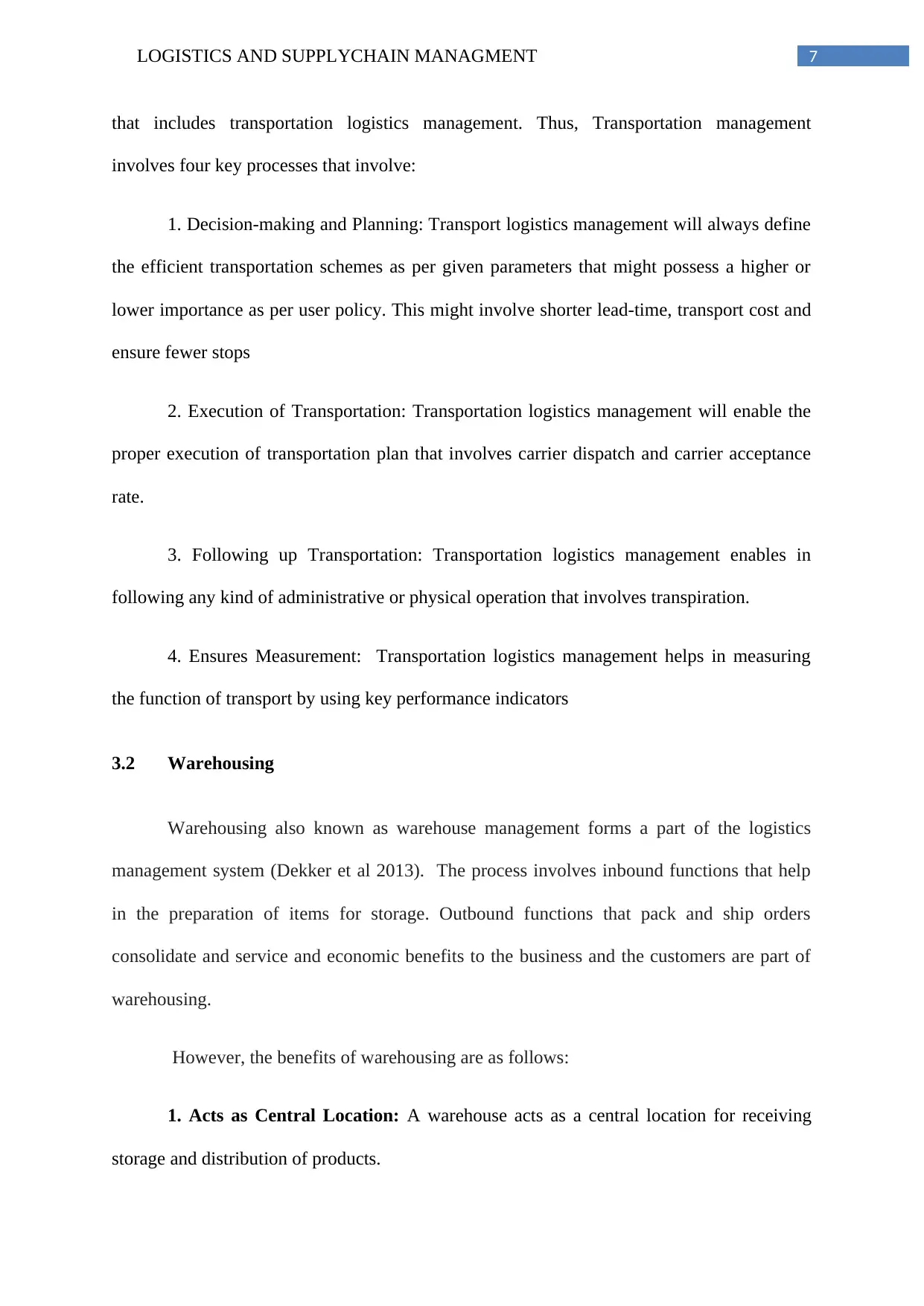
7LOGISTICS AND SUPPLYCHAIN MANAGMENT
that includes transportation logistics management. Thus, Transportation management
involves four key processes that involve:
1. Decision-making and Planning: Transport logistics management will always define
the efficient transportation schemes as per given parameters that might possess a higher or
lower importance as per user policy. This might involve shorter lead-time, transport cost and
ensure fewer stops
2. Execution of Transportation: Transportation logistics management will enable the
proper execution of transportation plan that involves carrier dispatch and carrier acceptance
rate.
3. Following up Transportation: Transportation logistics management enables in
following any kind of administrative or physical operation that involves transpiration.
4. Ensures Measurement: Transportation logistics management helps in measuring
the function of transport by using key performance indicators
3.2 Warehousing
Warehousing also known as warehouse management forms a part of the logistics
management system (Dekker et al 2013). The process involves inbound functions that help
in the preparation of items for storage. Outbound functions that pack and ship orders
consolidate and service and economic benefits to the business and the customers are part of
warehousing.
However, the benefits of warehousing are as follows:
1. Acts as Central Location: A warehouse acts as a central location for receiving
storage and distribution of products.
that includes transportation logistics management. Thus, Transportation management
involves four key processes that involve:
1. Decision-making and Planning: Transport logistics management will always define
the efficient transportation schemes as per given parameters that might possess a higher or
lower importance as per user policy. This might involve shorter lead-time, transport cost and
ensure fewer stops
2. Execution of Transportation: Transportation logistics management will enable the
proper execution of transportation plan that involves carrier dispatch and carrier acceptance
rate.
3. Following up Transportation: Transportation logistics management enables in
following any kind of administrative or physical operation that involves transpiration.
4. Ensures Measurement: Transportation logistics management helps in measuring
the function of transport by using key performance indicators
3.2 Warehousing
Warehousing also known as warehouse management forms a part of the logistics
management system (Dekker et al 2013). The process involves inbound functions that help
in the preparation of items for storage. Outbound functions that pack and ship orders
consolidate and service and economic benefits to the business and the customers are part of
warehousing.
However, the benefits of warehousing are as follows:
1. Acts as Central Location: A warehouse acts as a central location for receiving
storage and distribution of products.
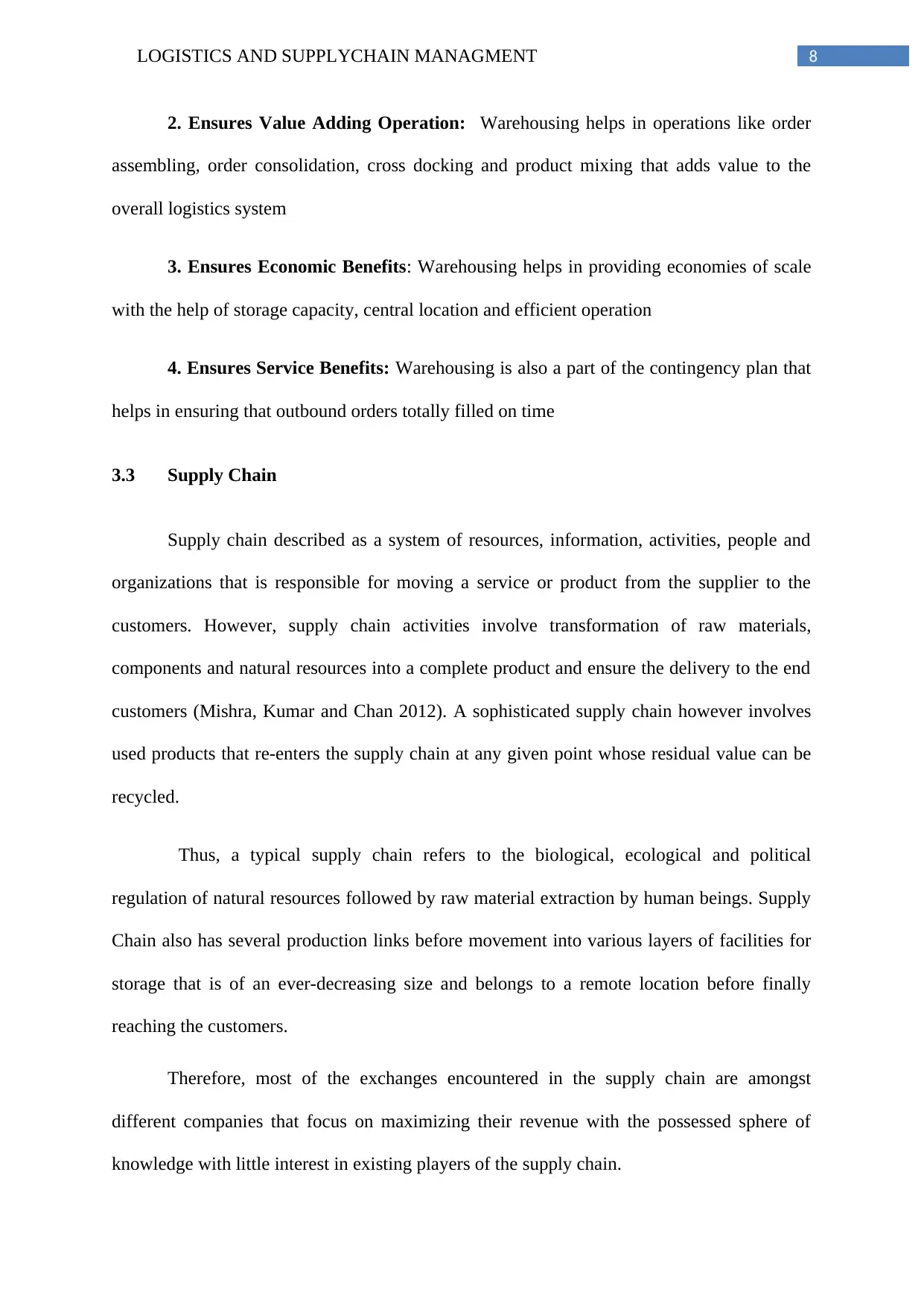
8LOGISTICS AND SUPPLYCHAIN MANAGMENT
2. Ensures Value Adding Operation: Warehousing helps in operations like order
assembling, order consolidation, cross docking and product mixing that adds value to the
overall logistics system
3. Ensures Economic Benefits: Warehousing helps in providing economies of scale
with the help of storage capacity, central location and efficient operation
4. Ensures Service Benefits: Warehousing is also a part of the contingency plan that
helps in ensuring that outbound orders totally filled on time
3.3 Supply Chain
Supply chain described as a system of resources, information, activities, people and
organizations that is responsible for moving a service or product from the supplier to the
customers. However, supply chain activities involve transformation of raw materials,
components and natural resources into a complete product and ensure the delivery to the end
customers (Mishra, Kumar and Chan 2012). A sophisticated supply chain however involves
used products that re-enters the supply chain at any given point whose residual value can be
recycled.
Thus, a typical supply chain refers to the biological, ecological and political
regulation of natural resources followed by raw material extraction by human beings. Supply
Chain also has several production links before movement into various layers of facilities for
storage that is of an ever-decreasing size and belongs to a remote location before finally
reaching the customers.
Therefore, most of the exchanges encountered in the supply chain are amongst
different companies that focus on maximizing their revenue with the possessed sphere of
knowledge with little interest in existing players of the supply chain.
2. Ensures Value Adding Operation: Warehousing helps in operations like order
assembling, order consolidation, cross docking and product mixing that adds value to the
overall logistics system
3. Ensures Economic Benefits: Warehousing helps in providing economies of scale
with the help of storage capacity, central location and efficient operation
4. Ensures Service Benefits: Warehousing is also a part of the contingency plan that
helps in ensuring that outbound orders totally filled on time
3.3 Supply Chain
Supply chain described as a system of resources, information, activities, people and
organizations that is responsible for moving a service or product from the supplier to the
customers. However, supply chain activities involve transformation of raw materials,
components and natural resources into a complete product and ensure the delivery to the end
customers (Mishra, Kumar and Chan 2012). A sophisticated supply chain however involves
used products that re-enters the supply chain at any given point whose residual value can be
recycled.
Thus, a typical supply chain refers to the biological, ecological and political
regulation of natural resources followed by raw material extraction by human beings. Supply
Chain also has several production links before movement into various layers of facilities for
storage that is of an ever-decreasing size and belongs to a remote location before finally
reaching the customers.
Therefore, most of the exchanges encountered in the supply chain are amongst
different companies that focus on maximizing their revenue with the possessed sphere of
knowledge with little interest in existing players of the supply chain.
⊘ This is a preview!⊘
Do you want full access?
Subscribe today to unlock all pages.

Trusted by 1+ million students worldwide
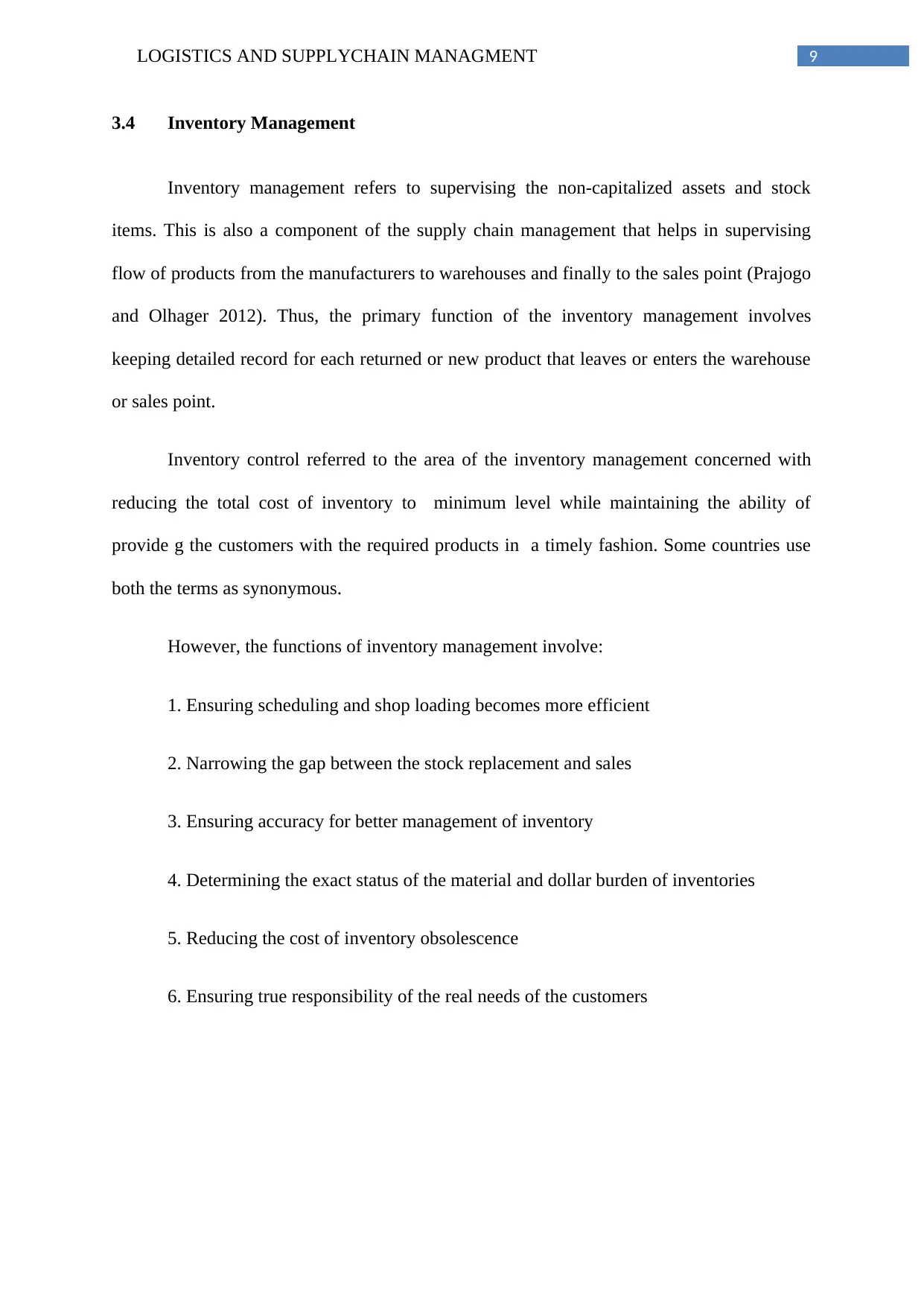
9LOGISTICS AND SUPPLYCHAIN MANAGMENT
3.4 Inventory Management
Inventory management refers to supervising the non-capitalized assets and stock
items. This is also a component of the supply chain management that helps in supervising
flow of products from the manufacturers to warehouses and finally to the sales point (Prajogo
and Olhager 2012). Thus, the primary function of the inventory management involves
keeping detailed record for each returned or new product that leaves or enters the warehouse
or sales point.
Inventory control referred to the area of the inventory management concerned with
reducing the total cost of inventory to minimum level while maintaining the ability of
provide g the customers with the required products in a timely fashion. Some countries use
both the terms as synonymous.
However, the functions of inventory management involve:
1. Ensuring scheduling and shop loading becomes more efficient
2. Narrowing the gap between the stock replacement and sales
3. Ensuring accuracy for better management of inventory
4. Determining the exact status of the material and dollar burden of inventories
5. Reducing the cost of inventory obsolescence
6. Ensuring true responsibility of the real needs of the customers
3.4 Inventory Management
Inventory management refers to supervising the non-capitalized assets and stock
items. This is also a component of the supply chain management that helps in supervising
flow of products from the manufacturers to warehouses and finally to the sales point (Prajogo
and Olhager 2012). Thus, the primary function of the inventory management involves
keeping detailed record for each returned or new product that leaves or enters the warehouse
or sales point.
Inventory control referred to the area of the inventory management concerned with
reducing the total cost of inventory to minimum level while maintaining the ability of
provide g the customers with the required products in a timely fashion. Some countries use
both the terms as synonymous.
However, the functions of inventory management involve:
1. Ensuring scheduling and shop loading becomes more efficient
2. Narrowing the gap between the stock replacement and sales
3. Ensuring accuracy for better management of inventory
4. Determining the exact status of the material and dollar burden of inventories
5. Reducing the cost of inventory obsolescence
6. Ensuring true responsibility of the real needs of the customers
Paraphrase This Document
Need a fresh take? Get an instant paraphrase of this document with our AI Paraphraser
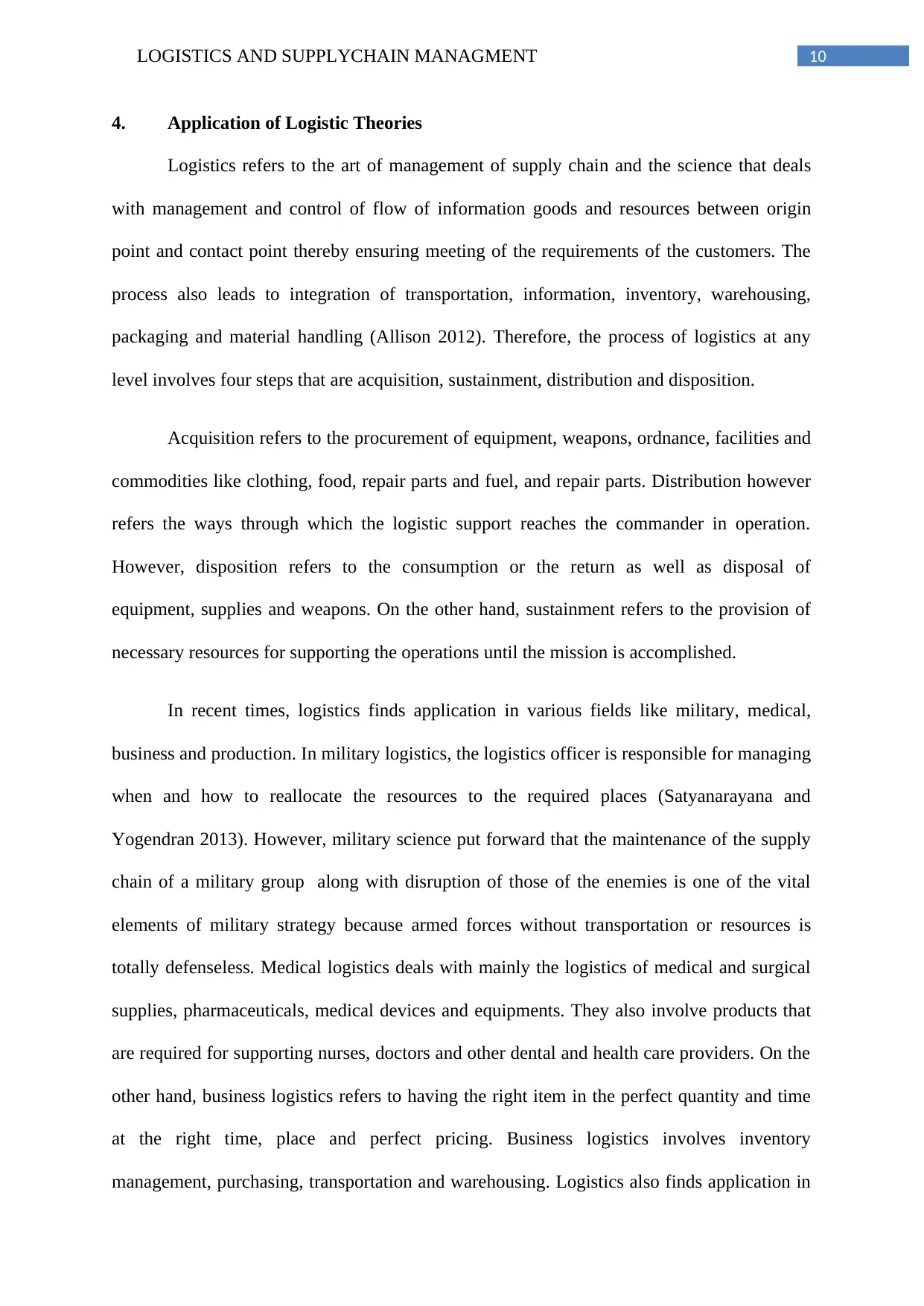
10LOGISTICS AND SUPPLYCHAIN MANAGMENT
4. Application of Logistic Theories
Logistics refers to the art of management of supply chain and the science that deals
with management and control of flow of information goods and resources between origin
point and contact point thereby ensuring meeting of the requirements of the customers. The
process also leads to integration of transportation, information, inventory, warehousing,
packaging and material handling (Allison 2012). Therefore, the process of logistics at any
level involves four steps that are acquisition, sustainment, distribution and disposition.
Acquisition refers to the procurement of equipment, weapons, ordnance, facilities and
commodities like clothing, food, repair parts and fuel, and repair parts. Distribution however
refers the ways through which the logistic support reaches the commander in operation.
However, disposition refers to the consumption or the return as well as disposal of
equipment, supplies and weapons. On the other hand, sustainment refers to the provision of
necessary resources for supporting the operations until the mission is accomplished.
In recent times, logistics finds application in various fields like military, medical,
business and production. In military logistics, the logistics officer is responsible for managing
when and how to reallocate the resources to the required places (Satyanarayana and
Yogendran 2013). However, military science put forward that the maintenance of the supply
chain of a military group along with disruption of those of the enemies is one of the vital
elements of military strategy because armed forces without transportation or resources is
totally defenseless. Medical logistics deals with mainly the logistics of medical and surgical
supplies, pharmaceuticals, medical devices and equipments. They also involve products that
are required for supporting nurses, doctors and other dental and health care providers. On the
other hand, business logistics refers to having the right item in the perfect quantity and time
at the right time, place and perfect pricing. Business logistics involves inventory
management, purchasing, transportation and warehousing. Logistics also finds application in
4. Application of Logistic Theories
Logistics refers to the art of management of supply chain and the science that deals
with management and control of flow of information goods and resources between origin
point and contact point thereby ensuring meeting of the requirements of the customers. The
process also leads to integration of transportation, information, inventory, warehousing,
packaging and material handling (Allison 2012). Therefore, the process of logistics at any
level involves four steps that are acquisition, sustainment, distribution and disposition.
Acquisition refers to the procurement of equipment, weapons, ordnance, facilities and
commodities like clothing, food, repair parts and fuel, and repair parts. Distribution however
refers the ways through which the logistic support reaches the commander in operation.
However, disposition refers to the consumption or the return as well as disposal of
equipment, supplies and weapons. On the other hand, sustainment refers to the provision of
necessary resources for supporting the operations until the mission is accomplished.
In recent times, logistics finds application in various fields like military, medical,
business and production. In military logistics, the logistics officer is responsible for managing
when and how to reallocate the resources to the required places (Satyanarayana and
Yogendran 2013). However, military science put forward that the maintenance of the supply
chain of a military group along with disruption of those of the enemies is one of the vital
elements of military strategy because armed forces without transportation or resources is
totally defenseless. Medical logistics deals with mainly the logistics of medical and surgical
supplies, pharmaceuticals, medical devices and equipments. They also involve products that
are required for supporting nurses, doctors and other dental and health care providers. On the
other hand, business logistics refers to having the right item in the perfect quantity and time
at the right time, place and perfect pricing. Business logistics involves inventory
management, purchasing, transportation and warehousing. Logistics also finds application in

11LOGISTICS AND SUPPLYCHAIN MANAGMENT
production that ensures that every machines and workstation fed with the perfect quality
product in the right quantity and time.
Logistics however helps in performance of functions that are not only strategic but
also tactical and operational. The strategic functions involve strategic optimization of
network that involves location, size of warehouse, facilities and distribution centers. They
also ensure strategic partnership with customers, distributors and suppliers (Chen and Sayed
2012). The strategic function also helps in product design and coordination, information
technology infrastructure and at the same time helps in the alignment of the strategy of the
organization with the supply strategy. On the other hand, the tactical functions involve
sourcing the contacts and purchase decisions. They also influence production decision related
to location, scheduling, contracting and planning. These functions also involve inventory
decisions and implementing the strategy for transformation (Audy et.al 2012). The tactical
functions also involve payments related to milestones and at the same time helps in
benchmarking all operations. However, the operational decisions involves distribution
planning and daily production, scheduling of production for each of the facilities for
manufacturing, demand forecasting and planning, sourcing the planning, inbound and
outbound operations, order promising and production operations.
Measurement of logistics done through Logistic Regression: This is a model used for
the prediction of probability of event occurrence. The model makes use of various predictor
variables that is either numeric or in categories (Lee et.al 2012). The model is extensively
used in social science, medical and marketing applications for predicting the propensity of the
customers in either purchasing the product or ceasing the subscription.
5. Challenges of Logistic Management
production that ensures that every machines and workstation fed with the perfect quality
product in the right quantity and time.
Logistics however helps in performance of functions that are not only strategic but
also tactical and operational. The strategic functions involve strategic optimization of
network that involves location, size of warehouse, facilities and distribution centers. They
also ensure strategic partnership with customers, distributors and suppliers (Chen and Sayed
2012). The strategic function also helps in product design and coordination, information
technology infrastructure and at the same time helps in the alignment of the strategy of the
organization with the supply strategy. On the other hand, the tactical functions involve
sourcing the contacts and purchase decisions. They also influence production decision related
to location, scheduling, contracting and planning. These functions also involve inventory
decisions and implementing the strategy for transformation (Audy et.al 2012). The tactical
functions also involve payments related to milestones and at the same time helps in
benchmarking all operations. However, the operational decisions involves distribution
planning and daily production, scheduling of production for each of the facilities for
manufacturing, demand forecasting and planning, sourcing the planning, inbound and
outbound operations, order promising and production operations.
Measurement of logistics done through Logistic Regression: This is a model used for
the prediction of probability of event occurrence. The model makes use of various predictor
variables that is either numeric or in categories (Lee et.al 2012). The model is extensively
used in social science, medical and marketing applications for predicting the propensity of the
customers in either purchasing the product or ceasing the subscription.
5. Challenges of Logistic Management
⊘ This is a preview!⊘
Do you want full access?
Subscribe today to unlock all pages.

Trusted by 1+ million students worldwide
1 out of 18
Related Documents
Your All-in-One AI-Powered Toolkit for Academic Success.
+13062052269
info@desklib.com
Available 24*7 on WhatsApp / Email
![[object Object]](/_next/static/media/star-bottom.7253800d.svg)
Unlock your academic potential
Copyright © 2020–2025 A2Z Services. All Rights Reserved. Developed and managed by ZUCOL.





